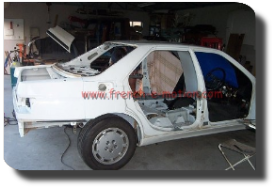french-e-motion
Hauptmenü
Peugeot 605 Pick up Part I
Peugeot > Peugeot 605
As many in the club know Kay and I have two 605s. The second was initially purchased for its engine, but proved to be too good a car to dismantle, so I brought it up to roadworthy condition and we use it as a runabout.
What most of you do not know is that we have a third 605! It was acquired at the end of last year and is a very low mileage Series one car. While the body and interior are in excellent condition the engine has been subjected to some rather poor repairs and required a full rebuild.
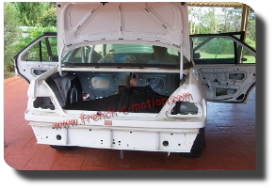
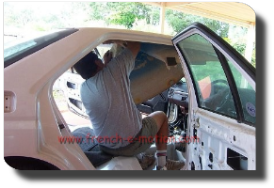
Having just sold the 604, the last thing I need is another big Peugeot sedan, what I do need is a decent ute. I know! I still haven’t finished the 404 ute, it’s next.
There are two things that you have to have before you can turn a sedan into a ute. Number one is an understanding wife! (I grovel a lot.) Number two is approval from Queensland Transport, this is the hard part!
To get an approval you first have to submit a detailed plan on the correct form along with A3 drawings showing plan, elevation and end views of the modifications you wish to do.
In my first submission I proposed lengthening the wheelbase as a means of gaining the tray bed length that I required, and duly posted the request at the post box down the road.
About a week later I read in our local newspaper that the post box down the road from us had been blown up and the contents destroyed. Not knowing if my request to Qld Transport had gone up in smoke I waited about a month and, having no reply, decided to submit another request to modify a vehicle.
This time I decided I did not need to extend the wheelbase but to extend the rear overhang by about 150mm. this I worked out would give me a tray length of 1900mm, which would be ample for my trials motorbike.
Another three months and I got a reply to my request, but they didn’t say yes and they didn’t say no? They wanted another submission! This time from a Qld Transport accredited engineer.
Luckily for me I know a Qld Transport approved engineer, so I gave Earl a call and asked the question – what the hell do Qld Transport want, and Earl suggested that I call Qld Transport and enquire about said submission and ask them if what they really wanted was a ‘beam and torsion test’ on the car as the type of modification didn’t fit any of their profiles. After several phone calls the answer was yes! I would have to do beam and torsion tests.
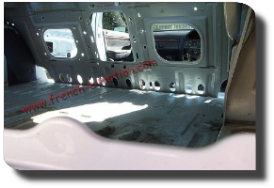
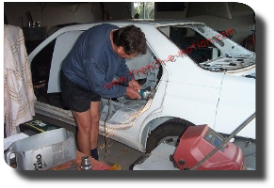
By this time I had already removed the engine and gearbox and had rebuilt most of the engine! I was still waiting for the front cover to be repaired and machined. I had also stripped out the interior of the car.
To carry out the beam and torsion test the car has to be set at its normal ride height with the suspension locked solid. The car is then mounted on a test rig and the stiffness of the body is measured as set weights are placed in strategic places in the car.
It seems that the 605 has an extremely stiff body shell, with readings approximately double that which is required by Qld Transport for individually constructed vehicles (ie kit cars and hot rods).
This testing, however, does not come cheaply, a total of $1500 for both the before and after test and to ensure that no body stiffness has been lost due to structural modifications.
With the first test completed it was time to remove the rear doors and rear windscreen. The rear door openings were then braced from the B to C pillars and the support frame for the ute tray welded in place. This additional bracing will stop the body shell distorting when the roof and rear panels are cut during the rebuilding process.
To be continued
